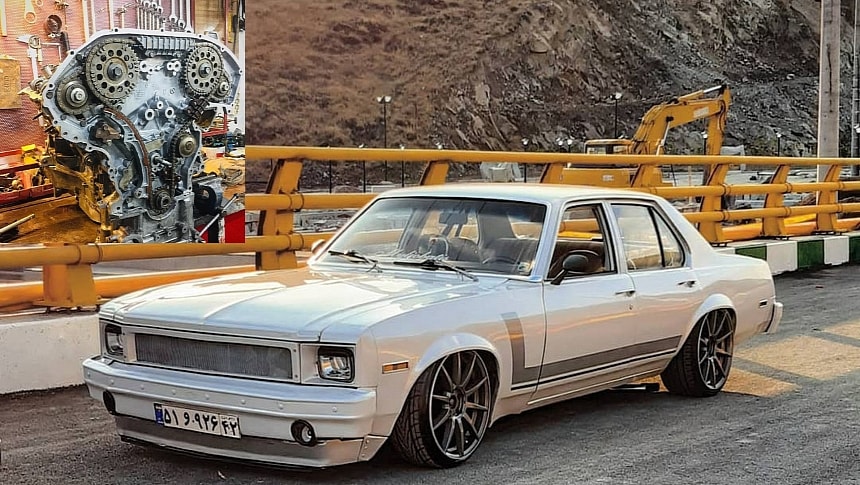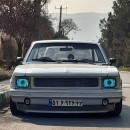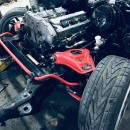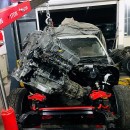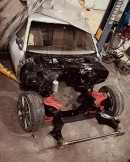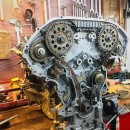After the early 1970s, the once much beloved Chevy Nova looked worse for wear. That was the case for just about any American car made after roughly 1973 or so; such is what happens when oil-producing nations of the world get their britches in a bunch and mess with the price of dino juice. The end result was a mid-size Chevy with all the bulk and mass of a full-sized one. It's not the kind of car you'd expect to get the Tokyo Drift experience a la the RB26-Swapped Mustang from the movie.
It's not quite a one-to-one equivalency of Sean Boswel's Mustang. This 1979 Nova sedan's taken on a similar JDM-American fusion motif that made the third installment of the Fast and Furious franchise such a memorable footnote in mid-2000s pop culture. This beyond-unique restomod is the product of the team at 8Garage in Iran, one of the very few shops in the area with any sort of expertise in older American iron from before the great split between Iran and the West in 1979.
So then, they're the perfect group to get the most out of a Malaise-era Nova. From the factory, fourth-generation Chevy Novas left the factory sporting one of five different six or eight-cylinder engines, none of which were all that inspiring. In North American-spec Novas, these engines were so choked by restrictive emissions regulations and archaic catalytic converter technology that they were mere shells of what they use to be. If you wanted, you could even abandon all pretenses of performance and opt for the putrid Iron Duke four-banger.
Ironically enough, gen-IV Novas were manufactured under license at the Pars Khodro facility in Tehran, Iran, up until the fall of the Shah's government and subsequent installation of the Ayatola in the late 1970s. However, once 8Garage removed most of the stock drivetrain, a three-liter Nissan VQ30DE V6 engine out of an early 2000s Nissan Maxima jetting between 190 and 227 horsepower depending on the market it's being sold in. With a dual-runner intake manifold for improved acceleration performance, this is the kind of engine that's surprisingly perfect for a JDM-American restomod.
All this power is fed to a five-speed W57 manual gearbox from Toyota of all places and then to a rebuilt ten-bolt rear end to help put power down to the tarmac properly. The stock suspension is now replaced with a baller airbag unit and disk brakes at all four corners with forged alloy wheels, and when we tell you this Nova's had a glow-up like a literal supernova, we really mean it. Side note, it's genuinely wonderful to see genuine American iron in a country so historically opposed to the US. Just goes to show muscle car charm has some staying power.
So then, they're the perfect group to get the most out of a Malaise-era Nova. From the factory, fourth-generation Chevy Novas left the factory sporting one of five different six or eight-cylinder engines, none of which were all that inspiring. In North American-spec Novas, these engines were so choked by restrictive emissions regulations and archaic catalytic converter technology that they were mere shells of what they use to be. If you wanted, you could even abandon all pretenses of performance and opt for the putrid Iron Duke four-banger.
Ironically enough, gen-IV Novas were manufactured under license at the Pars Khodro facility in Tehran, Iran, up until the fall of the Shah's government and subsequent installation of the Ayatola in the late 1970s. However, once 8Garage removed most of the stock drivetrain, a three-liter Nissan VQ30DE V6 engine out of an early 2000s Nissan Maxima jetting between 190 and 227 horsepower depending on the market it's being sold in. With a dual-runner intake manifold for improved acceleration performance, this is the kind of engine that's surprisingly perfect for a JDM-American restomod.
All this power is fed to a five-speed W57 manual gearbox from Toyota of all places and then to a rebuilt ten-bolt rear end to help put power down to the tarmac properly. The stock suspension is now replaced with a baller airbag unit and disk brakes at all four corners with forged alloy wheels, and when we tell you this Nova's had a glow-up like a literal supernova, we really mean it. Side note, it's genuinely wonderful to see genuine American iron in a country so historically opposed to the US. Just goes to show muscle car charm has some staying power.
